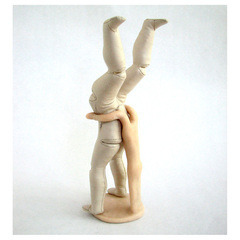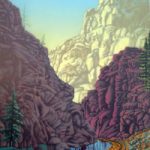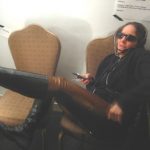Meet a NYFA Artist: Claire Watson
NYFA speaks with 2007 Sculpture Fellow Claire Watson
NYFA: Hi Claire, Please tell us what are you working on or what’s coming up for you.
CW: I’m working on three distinct series. In one, I’m making sculpture from baked (burnt) salt-bread. The salt dough is kneaded, and modeled into forms that refer directly or obliquely to the human form.
Some incorporate other materials, such as hair. They’re baked until rock hard, or until they emerge from the oven scorched, and then varnished. When they succeed, the individual sculptures are desirable but inconsumable, and collectively they comprise a fragmented whole.
In another, I’m constructing “accidental” portraits from found mannequin and doll heads and Cernit clay. The clay models like wax when soft, and carves like stone when cured, but has the translucency of flesh.
I’m also developing a series of cast and carved chalk figures that erase themselves by writing or drawing, on slate or other chalkboard surfaces. This is leading to experiments with stop frame animation, and proposals for installations.
For the time being, production can’t keep up with the flow of ideas.
NYFA: When did you realize you were an artist, and how did you choose your medium?
CW: As a child, I thought of myself as an artist. I never really considered doing anything else. I studied photography and painting as an undergraduate, but as a photographer I studied objects, and as a painter I created objects. I suppose I chose my discipline when I realized that as an object maker I should make my application to graduate school as “sculptor. “
NYFA: Do you collect anything?
CW: Books, mainly. When I’m drawn to collecting things it’s because the objects have an effect on my art making. It’s usually poetic, rather than formal properties, that attract me. Tobacco pipes, kid gloves, wooden kitchen and sewing tools, and doll and mannequin parts …
NYFA: How do you start on a project?
CW: In the best of times, ideas for new work come simply out of the daily habit of working. Completing one project or series and starting on any new project requires only faith (that something will come from the effort) and a sense of freedom (that anything is permissible.) I do my best not to analyze what I’m making as I’m making it.
I’ve had the experience of beginning again after a long hiatus. When my sons were very young I produced work only in my notebooks for nearly ten years. Over time, while not-working, I began collecting kid gloves and eventually to alter them using doll patterns. Sewing was something I could do without separating myself from my children. The hours spent with needle and thread connected me to long traditions of women’s handwork, and the smudges on the fingertips attached me to the women who had worn them on special occasions. These were the hooks that brought me back to daily studio practice. I began to look for other objects that held a particularly feminine history. Wooden kitchen and sewing tools, especially those that seemed to embody an arcane domestic purpose, were starting points for a new series. One thing leads to another. Work usually results from putting my hands on materials and engaging in play.
NYFA: What is your studio or workspace like?
CW: My studio proper is a room in the basement. I use it mainly when a project involves a lot of dust or a sustained mess, or when I need to cocoon myself while figuring something out. I work at my kitchen table. When I realized that I could work without sequestering myself, I was able to fold my studio routine into my family life. My family is long accustomed to my habit and very tolerant of disorder.
NYFA: What role has your NYFA Fellowship played in your life?
CW: The Fellowship has certainly enhanced my resume, and has probably helped some viewers to take a second look at my work. In that sense it has helped to open doors. The Fellowship has also provided the means to afford materials and time to create. In a more fundamental way, though, the panel’s acknowledgement has given me confidence to experiment, to take risks, to take my ideas and run with them. For that I’m most grateful.
For more information on Claire Watson, visit her website.





